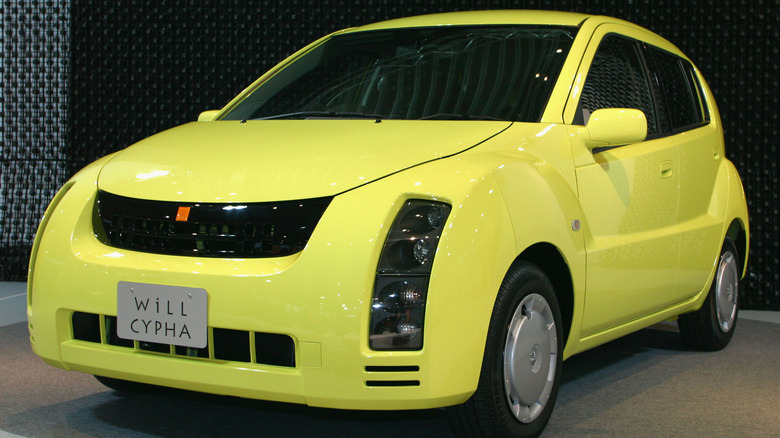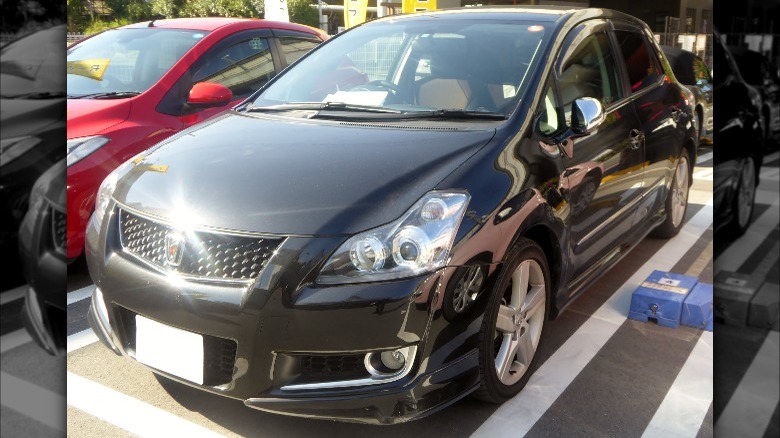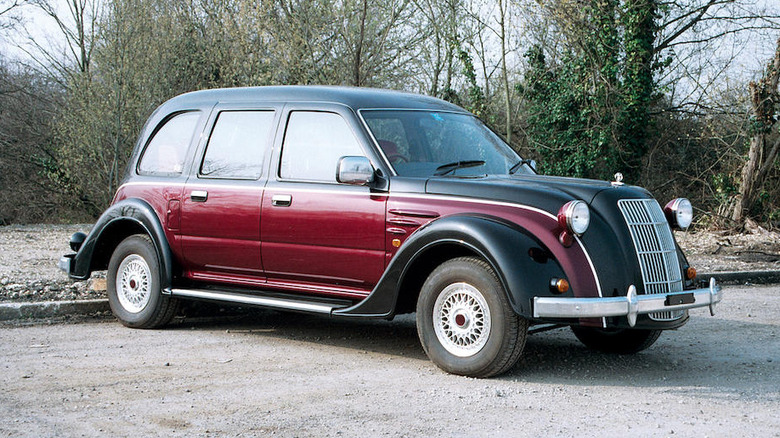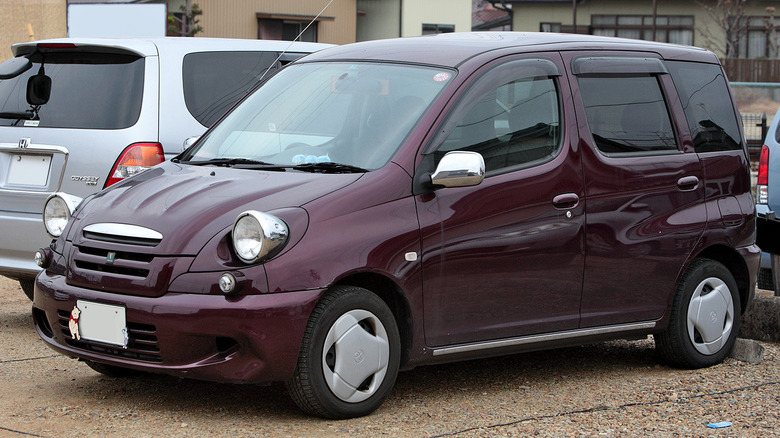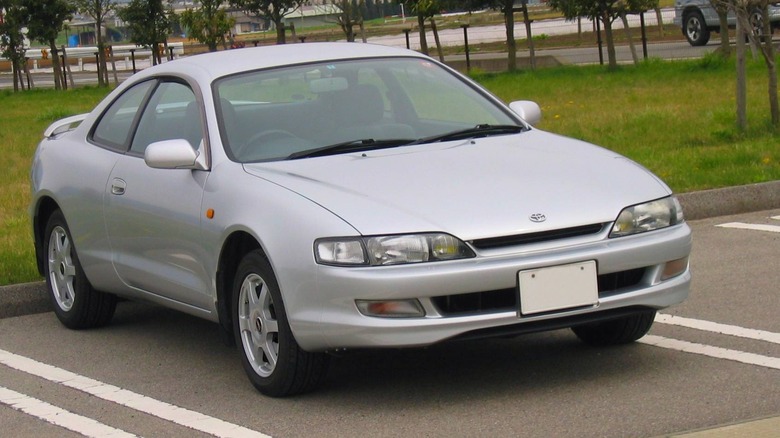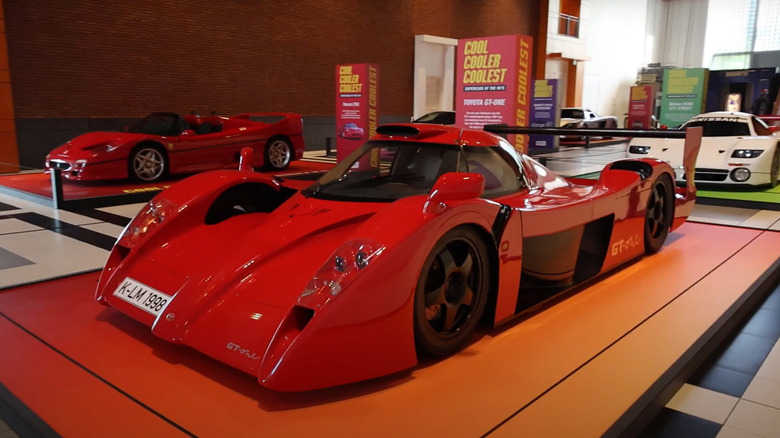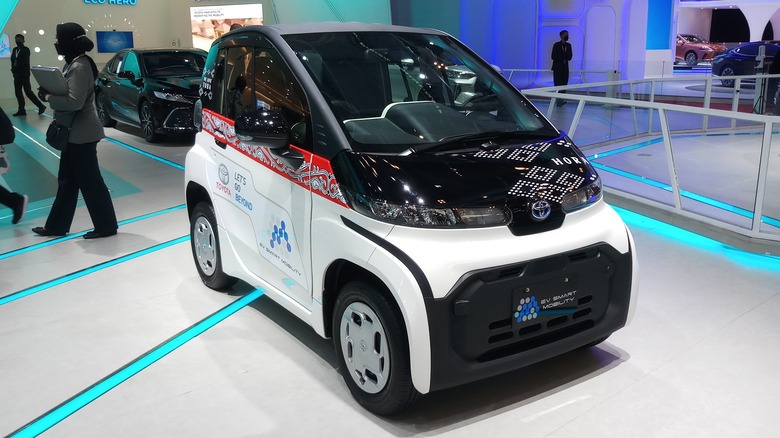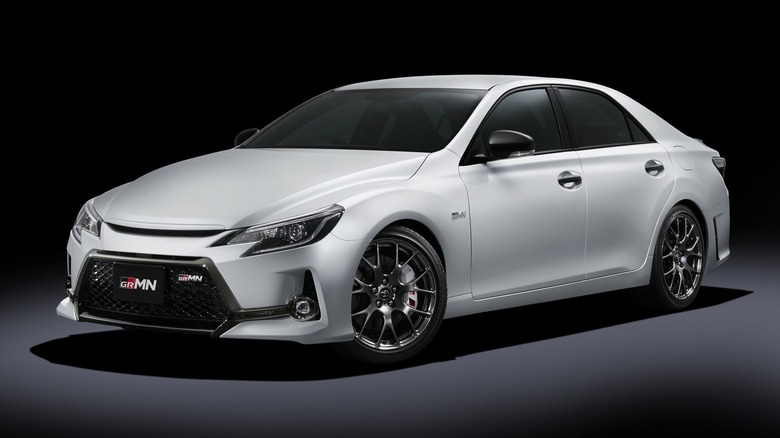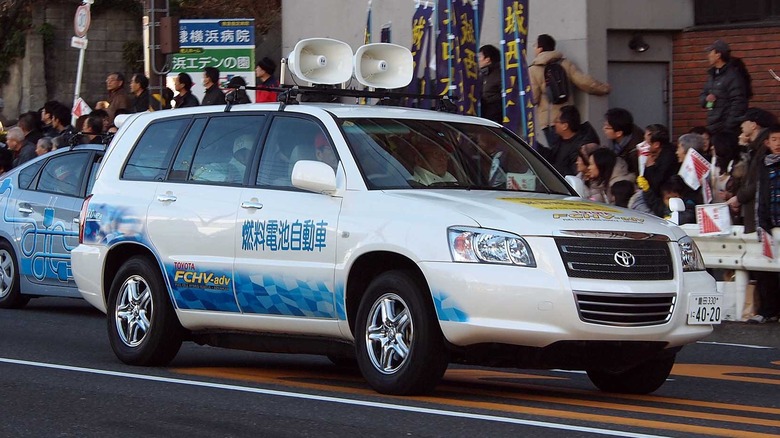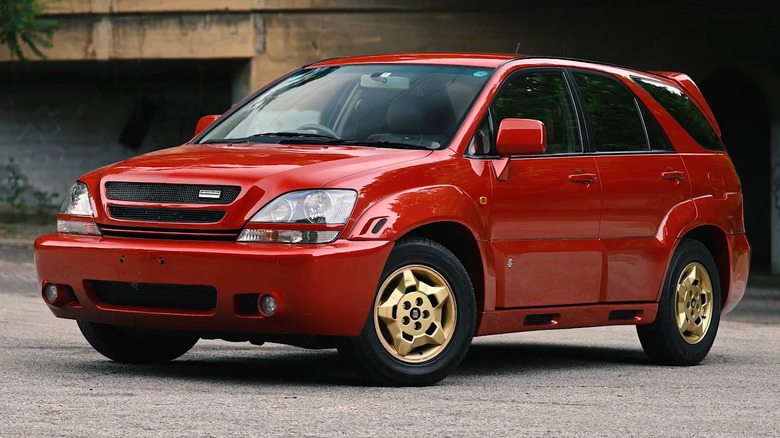12 Toyota Models You Didn't Realize Existed
In September 2023, Toyota reached the milestone of producing 300 million cars globally since its founding, with over 53 million examples produced of the Corolla alone. With that many cars in its back catalog, it's almost impossible to keep track of all of them. Some are household names, and others are enthusiast favorites, but there are always some that tend to go under most Toyota owners' radars. Many of those were produced for short periods, in low numbers, or restricted to Toyota's home market of Japan.
Some are simply unremarkable cars that are tailored to specific markets, but others — particularly Toyota's most obscure JDM models — are worth knowing about. From Hummer-rivaling off-roaders to road legal Le Mans racers, Toyota's least known models are often some of its most interesting. SlashGear dug through the brand's archives to uncover a range of little known models that many enthusiasts won't have heard of.
Toyota WiLL Cypha
The WiLL brand was not solely the creation of Toyota, but rather was a collaborative project that involved several major Japanese companies at the turn of the century. Toyota was responsible for designing and producing cars for the project, and unveiled several models, each one aimed at attracting younger buyers. The WiLL Cypha was the most futuristic car to emerge from the project, featuring Toyota's G-Book infotainment system which included a navigation system, email connectivity, and even an inbuilt restaurant reservation system.
It was available with two-wheel-drive as standard, but all-wheel-drive was optional. Buyers of the former got a 1.3L engine while buyers of the latter got a 1.5L unit. As well as being innovative in both its technology and its looks, the WiLL Cypha was also offered under a unique leasing system that charged users by the amount of mileage they drove. Each month, the G-Book system would log the car's mileage and send a report back to Toyota, who would bill the driver based on that figure.
All these innovations didn't translate to sales figures, and the Cypha, alongside its other WiLL branded stablemates, never sold well. Toyota axed the car in 2005 after only a few years on sale, and discontinued its involvement in the WiLL project shortly after.
Toyota Mega Cruiser
Toyota's rival to the Humvee was, much like its American counterpart, originally designed for military use. A civilian version was introduced in 1996 with Toyota billing it as a capable all-terrain rescue vehicle for agencies and emergency services. A significant number of examples ended up doing duty as ambulances or as mountain rescue trucks, but plenty of examples were bought by well-heeled owners as personal vehicles.
Officially, the Mega Cruiser was sold only in Japan, but it was sold as a gray import in many other markets from Australia to Kazakhstan. The truck was far from fast — its 4.1L turbodiesel engine churned out around 150 horsepower — but it was highly capable across almost any terrain. An adjustable tire pressure system helped it conquer snow and mud, while its 16.5-inch ground clearance ensured that rough and rutted tracks were no obstacle.
Roughly 100 civilian examples of the Mega Cruiser were reportedly produced between 1996 and 2001, all of which were right-hand drive. With its six seats and a 1,650-pound cargo carrying capacity, it remains unlike anything else produced by Toyota before or since. Given the current market's penchant for huge, over-engineered trucks, it's also arguably ripe for a modern resurrection.
Toyota Blade Master-G
The 2007 Toyota Auris was not a particularly interesting car, although it birthed a rare Japan-only spin-off that's much more unique. The Blade was unveiled alongside the Auris as a more upmarket sibling, with the two cars sharing a platform but the Blade featuring a larger 2.4L engine and a fancier interior. At launch, it wasn't particularly remarkable, but then Toyota released a hotter variant called the Blade Master-G, with a 276 horsepower V6 engine borrowed from the Lexus IS.
The Blade Master-G was tested at launch by Autocar, who reported that it felt closer to a luxury GT than a hot hatch. It was significantly faster than a standard Blade and a world away from the dull Auris, but its handling was smooth rather than sharp and it was designed more for comfort than raw performance as a traditional hot hatch would be.
It remained front-wheel-drive, like its everyday counterparts, but despite that, the outlet reported only minimal understeer. The Blade Master-G was never sold outside of Japan, and that's understandable — it's unlikely most export markets would have found this niche hot hatch-GT combination too appealing anyway.
[Featured image by Tokumeigakarinoaoshima via Wikimedia Commons | Cropped and scaled | CC BY-SA 4.0]
Toyota Classic
It might not look like it, but hiding underneath the body of this strange Toyota is a Hilux pickup truck. The Toyota Classic was launched in 1996 and was designed to pay homage to the AA, the automaker's first passenger car, which had begun production exactly six decades earlier. The Hilux chassis was the closest contemporary platform in dimensions to that of the original AA, and so Toyota decided to use it as the base for this limited-run special.
Only 100 units of the car were produced, with each one built by Toyota's in-house coach-builder Technocraft. When it wasn't busy churning out specials like the Classic, Technocraft was also responsible for running the brand's racing outfit TRD, and strangely enough, for its ambulance building program.
As well as borrowing its chassis, the Classic also borrowed the Hilux's engine, a 2.0L four-cylinder making a little under 100 horsepower. So, buyers certainly weren't purchasing a Classic for its performance, but instead it was its retro-modern styling and upscale interior that won them over. It's not known exactly how many survive today, but a few examples have been exported overseas in the years since its release. One example appeared at a Bonhams auction in the UK and sold for £9,775 (roughly $16,000 at the time).
Toyota Modellista VF130
Modellista is Toyota's in-house modification division, having been first established as a Toyota subsidiary in 1997. It's not well-known outside Japan, but has released a series of limited run special edition cars that take popular Toyota models and give them unique bodywork, performance upgrades, or both. The Modellista VF130 was one of the division's earlier works, being based on the popular JDM FunCargo but with its front end redesigned to look like a Citroen 2CV.
The FunCargo itself remains largely unheard of in export markets, despite being popular at the time of its launch in Japan. It sold 350,000 units during its production and was based on the Vitz/Yaris. An export version of the FunCargo was marketed as the Yaris Verso in some European markets. In contrast to the high sales of the regular FunCargo, the Modellista VF130 was reportedly limited to just 350 units. Examples occasionally appear for sale in Japan, but there are no examples known to have been exported outside of its home market to date.
[Featured image by Tennen-Gas via Wikimedia Commons | Cropped and scaled | CC BY-SA 3.0]
Toyota Curren
A mostly unknown sibling of the Celica, the Toyota Curren fell victim to '90s Japan's crowded coupe market. It was sold only in Japan and was closely related to the export market Celica coupe, being almost mechanically identical. However, the Curren offered a more grown-up, understated exterior design, with the thin headlamps being the most notable difference. According to a press release from its launch, Toyota thought the Curren would attract young drivers, with the brand aiming to sell around 2,000 examples per month.
However, this figure would prove to be too optimistic, with sales figures across the car's four year lifespan reportedly only totalling around 40,000. It seems Japanese buyers simply overlooked it in favor of the many other options on the market, with Toyota's rivals like Honda, Mazda, and Nissan all having their own similar competitors. Among the most successful was the Honda Prelude, which was in its fourth generation by the time the Curren was launched. Today, the car remains readily available on the Japanese used market, but largely unheard outside of the country.
[Featured image by Qurren via Wikimedia Commons | Cropped and scaled | CC BY-SA 3.0]
Toyota TS020 GT-One (Road Car)
Unlike the other cars here, the Toyota TS020 GT-One was never designed for the road at all, at least not primarily. In fact, the only reason that one example ended up wearing a license plate was that homologation requirements demanded that a roadgoing version of every Le Mans GT1 entry be built.
Reports differ over whether one or two road-legal examples were constructed, but only one gained a license plate in Toyota Motorsport Europe's home country of Germany. It's known by its plate number, K-LM 1998. Toyota had to come up with some creative ways to meet the homologation regulations, with one of the trickiest problems being that the rules stated that a car had to have storage room for at least one suitcase. However, they didn't specify where that room had to be, so Toyota successfully argued that the car's fuel tank could technically house a suitcase.
The rest of the car was hastily assembled with various switchgear from Toyota's parts bin, and was not in a state to be publicly sold. It would turn out that it never needed to be — before Toyota ever got around to putting it on sale, the governing body in charge of Le Mans changed its homologation rules, making the road-going GT-One redundant. It remained in storage at Toyota's European motorsport facility for several decades, but was recently recommissioned and exhibited at the Louwman Museum in the Netherlands in 2024.
Toyota Origin
To celebrate making 100 million cars in Japan, Toyota unveiled the Origin, a retro-modern luxury car that combined a contemporary powertrain and tech with classic looks. It was assembled by the same technicians that usually produced the Century, Toyota's Rolls-Royce-rivaling limousine. The car was styled to look like the first generation Crown, which launched in 1955, a full 45 years prior to the launch of the Origin.
Only 1,000 units of the car were built and, like many of the obscure cars here, it was only sold in Japan. Toyota treated the car to the same traditional lacquering techniques used for the Century's paintwork, which gave it a smoother, more reflective finish than mass-produced models. The interior was equally luxurious, with plush leather and fine wood trim used throughout the cabin. Under the hood sat a BEAMS 2JZ-GE, making 212 horsepower and mated to an automatic transmission.
Examples can be readily found on the used market in Japan, but thanks to their luxury and rarity, they command significantly higher prices than most other Toyotas of their age. The most pristine examples command prices in excess of $100,000, although most examples cost less than half that figure.
[Featured image by Tokumeigakarinoaoshima via Wikimedia Commons | Cropped and scaled | CC BY-SA 4.0]
Toyota C+pod
Japan's densely populated cities mean that large, powerful cars are not necessary for citizens living in urban areas. Instead, kei cars remain a popular solution, and in recent years, certain classic kei cars have become increasingly popular with collectors outside of Japan. Toyota's C+Pod is even smaller than most kei cars, with its interior being just 43 inches wide. That's just about enough room for two seats, with only a token amount of cargo space available behind them.
The C+pod is electric and boasts a range of around 93 miles, which is plenty to deal with Japanese city commutes and grocery runs. The car is limited to 37 mph to prolong that range — again not an issue in congested city centers, but too slow to make it viable to drive elsewhere. According to the brand, it's targeted at two main groups: "young, single new drivers, or older individuals who may be nervous about driving." Toyota launched the car for public sale in 2021 after initially trialing it with corporate clients at a price of just 1.65 million Yen (around $11,300).
Toyota Mark X GRMN
At the Tokyo Auto Salon in 2019, Toyota unveiled a 314 horsepower V6 sports sedan with a six speed manual and rear-wheel-drive — then, much to the annoyance of enthusiasts globally, confirmed it would only be available in Japan. It's the kind of performance sedan that would likely be very popular across America, Europe, and elsewhere, but virtually no-one outside of Japan will ever get to drive one, since the car was limited to just 350 units.
The Mark X GRMN is a sportier version of the long-running JDM Mark X sedan, with a stiffer chassis and performance suspension as well as a power boost over the standard model. It boasts 19-inch BBS wheels and an optional carbon fiber roof panel, while subtle exterior accents like the rear wing and new bumpers let passersby know this is no regular Toyota sedan. At a price of 5.13 million Yen (around $47,000 at the time), the Mark X GRMN was more expensive than a standard Mark X, but still affordable by American market standards. Examples can be found on the used market, but they often list with asking prices higher than their original retail price.
Toyota FCHV-adv
Toyota's first mass-produced hydrogen car was the Mirai, but before that, the automaker built a small number of hydrogen-powered SUVs that most people will have forgotten about — if they ever knew they existed at all. The Toyota FCHV-adv's name might look like a cat trod on a keyboard, but it describes the car's place in Toyota's hydrogen history. FCHV stands for Fuel Cell Hybrid Vehicle, and since it was an evolution of the original Toyota hydrogen SUV prototypes, it was "advanced," hence "adv."
Around 100 examples of the car were built and leased out in California and New York, alongside a small number in Japan, with the intention being that data gathered from these early vehicles would help shape a future mass-produced model. That model would turn out to be the Mirai, which was launched in 2014, four years after the FCHV-adv. The production Mirai would end up having a shorter range than the FCHV-adv – around 400 miles compared to the latter's 515 miles — but was able to use a much smaller tank thanks to Toyota's advances in power output density.
[Featured image by Comyu via Wikimedia Commons | Cropped and scaled | CC BY-SA 3.0]
Toyota Harrier Zagato '98
To drum up interest in its newly launched Harrier crossover — better known in export markets as the Lexus RX — Toyota commissioned Zagato to design a body kit for the car which would be limited to 250 units. The result was the Harrier Zagato, which was sold through Toyopet dealerships and featured virtually every option available on the Harrier. The crossover's 220 horsepower 3.0L V6 engine was fitted to each example, alongside lowered suspension and a wider track to improve handling.
Most examples remained in Japan, but a few have escaped over the years and several examples are known to reside in the UK. One has also made its way over to the USA, since it's now old enough to be imported under the 25-year rule. Toyota later revived the partnership with Zagato for another edition of the Harrier Zagato in 2006. The newer model featured a less outlandish body kit but was equally rare, with 250 examples being produced for the Japanese market only.

